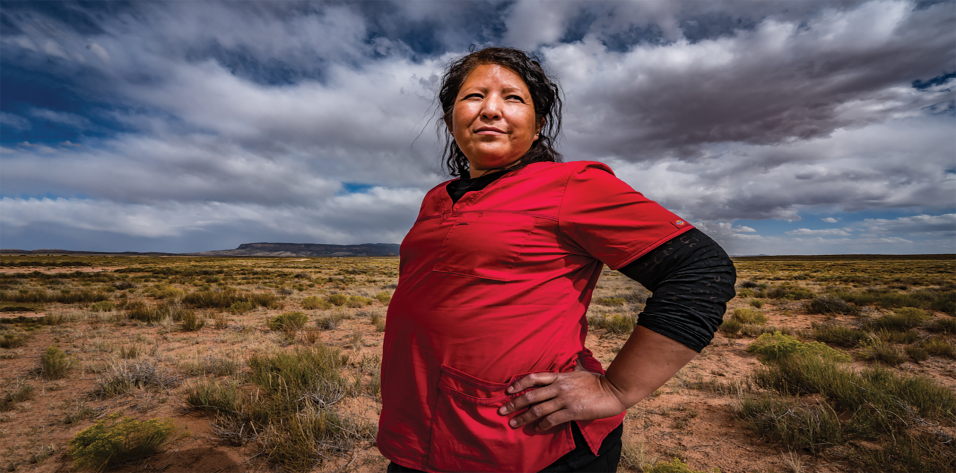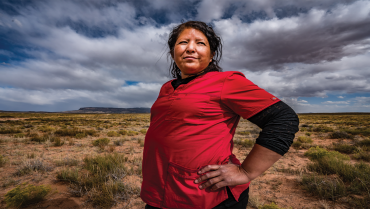I am sitting in clinic on a Saturday in the town of Montezuma Creek in the Navajo Nation, located in southern Utah in the Four Corners region (Figure 1). Navajo Nation sits mostly in three states: Utah, New Mexico, and Arizona. The area is stunning in its beauty (Figure 2). It encompasses Monument Valley, borders the Grand Canyon and Lake Powell, and surrounds the Hopi Reservation. It is a destination for thousands of visitors yearly, seeking to experience the majestic views and to set foot where many early Western films were made.
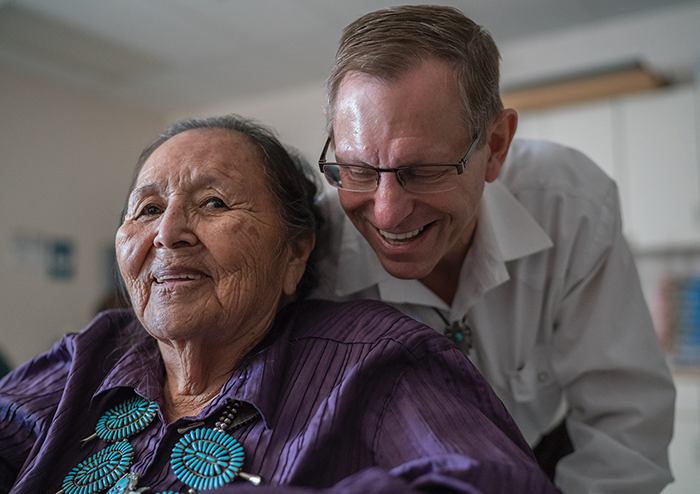
Figure 1 | Dr. Crandall and a patient in Navajo Nation.
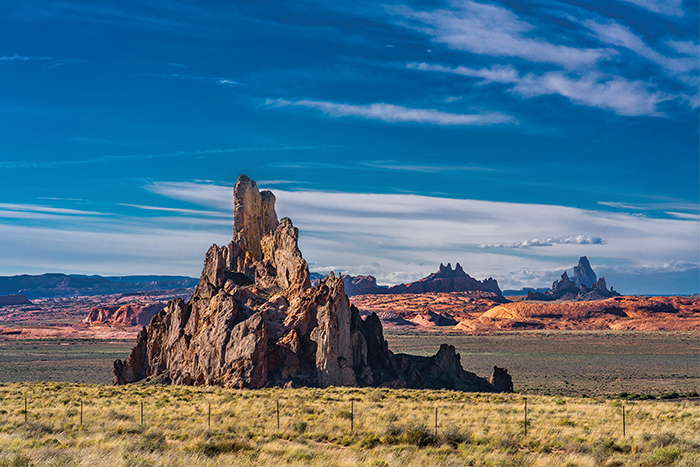
Figure 2 | Navajo Nation sits mostly in Utah, New Mexico, and Arizona.
Despite this idyllic landscape, the Native American population here has experienced more than its fair share of disparities, with health care at or near the top of the list. Living in the remote Four Courners region of the United States, health care for members of the Navajo population is characterized by poor infrastructure, old facilities and equipment, lack of resources, and limited availability of personnel. The state of eye care within the Navajo population is no better than that of general health care.
NAVAJO NATION
With a population of more than 350,000 people, the Diné Bikéyah, or Navajoland, is the largest land area retained by a Native American tribe. It covers more than 27,000 mi2, is larger in area than 10 of the 50 states in America, and is considered a sovereign nation.1
Along the strip of Navajo Nation that lies in Utah, there are few paved roads. Many occupants live without running water, electricity, phones, or computers, and many have no access to health care. The Navajo reservation is also considered to be a food desert, with little fresh food grown there and adequate grocery stores few and far between. According to the Diné Policy Institute, there are only 10 full-service grocery stores on the entire reservation.2 Most food shops are convenience stores, leaving residents with little choice but to eat highly processed, high-calorie, low-nutrition foods.
These issues have created a larger problem with regard to the health of many Navajo natives. The Indian Health Services (IHS) reports that approximately 10% of Navajo Nation residents have diabetes, 30% have prediabetes, and the rate of obesity ranges from 23% to 60%.2 Along with high rates of heart disease, hypertension, alcohol use, depression, and domestic violence, the mortality rate of individuals in the Navajo population is higher than that among age-matched peers.3
Eye disease is often secondary to primary disease, and it affects individuals of all ages in the Navajo population. Common conditions include treatable cataracts, glaucoma, trachoma, diabetic retinopathy, hypertension retinopathy, trauma, and high refractive errors. These untreated eye diseases affect more than just the patient with associated pain and/or blindness. Family members and friends suffer along with the individuals who are unable to care for themselves or their families, imposing a life of continual poverty.
The impact of these and other issues can be seen in the number of children who are unable to attend school. The children who do attend school are often two to three grades behind their age-matched peers outside the Navajo Nation (personal communication).
For years, the Navajo population has gone unrecognized as a locus for primary diseases and the secondary health care issues that follow, including ocular disease. In a statement to the Subcommittee on Interior, Environment, and Related Agencies of the House of Representatives’ Committee on Appropriations, Kelly Moore, FAAP, noted that it is difficult to effectively address a health problem without scientifically defining the problem and its determinants, testing promising interventions, and systemically monitoring their impacts on communities, including changes in health status, community acceptance, and sustainability.4
In essence, you cannot determine progress unless you can measure it.
LITERATURE REVIEW
The prevalence of visual impairment in Navajo Nation has not yet been determined on a large-scale basis. A review of the peer-reviewed literature provides a glimpse into the state of diseases among the Native American population; however, most information is at least 20 to 30 years old. There are even fewer studies showing the prevalence of ocular diseases in the Navajo population, specifically eye disease secondary to primary conditions such as hypertension and diabetes, congenital disorders, or trauma, and examining how they can be treated, prevented, or cured.
For this article, I searched PubMed, Scopus, and the Wiley Online Library for the terms Native American visual health; Navajo ocular disease; Navajo health disparities; Navajo diabetes; Navajo refractive error, astigmatism; Navajo children disease; and Navajo ethics research. I found 43 articles that were relevant.
In a 2006 article, David Jones, MD, PhD, wrote that inequalities in the Native American population have existed not just for the past 50 years of modern science, but for the past 500 years.5 This is likely one of the many reasons American Indians are reluctant to seek out Western medical care. Dr. Jones commented that many reasons for the persistence of health disparities among the Native American population have been reported in the literature; however, most authors blame the Native American diet, religion, cultural practices, socioeconomic status, and/or genetics. In truth, Dr. Jones concluded, the lower life expectancy and disproportionate disease burden exist because of inadequate education, poverty, discrimination in the delivery of health services, and cultural differences.
A 1999 IHS report supports Dr. Jones’ findings, showing that mortality rates among American Indians/Alaskan Natives (AI/ANs) were higher compared with their age-matched peers from the general population, as were their rates of heart disease, accidents, diabetes, alcohol use, suicide, and tuberculosis.6 A 2002 report by Yvette Roubideaux, MD, MPH, a former director of IHS, showed that AI/AN individuals experienced disparities in health when compared with the general US population; we are now seeing an even larger divide and new challenges due to rising rates of chronic diseases.7
A 2010 report showed that, since the late 1990s, mortality rates among AI/ANs have been higher than in all other US races combined.8 This report described challenges in bringing health care to the reservations, such as disparities in access and utilization, less insurance coverage, old facilities and equipment, and lack of sufficient resources, all of which contribute to the already-overburdened Navajo medical system.
Mansberger et al9 studied chart reviews and examined a random sample of AI/AN individuals 40 years of age and older from three different tribes. They showed that uncorrected refractive error was the most common form of visual impairment in the AI/AN population, followed by cataracts, retinal disease, and normal-tension glaucoma. The study also found that vision problems are the second leading cause of overall impairment in the AI/AN population.
Another important finding of the Mansberger et al study was that, although the reasons for blindness remained steady throughout different Southwest and Northwest Native American tribes, the leading causes of blindness in each tribe were different. The study authors concluded that addressing the need for visual acuity correction (ie, glasses) was the primary way to improve quality of life in this population.
MORE THAN GLASSES
It is not as simple, however, as saying, “The Navajo population needs glasses.” Data collected by the John A. Moran Eye Center identified extraordinarily high amounts of farsightedness, nearsightedness, or corneal astigmatism in children 2 to 18 years of age and in most adults (personal communication, November 2014). Often, adults and children can function if the correction needed is for nearsightedness or farsightedness only, but, in the Navajo population, the combination of the two conditions makes it difficult to function at any distance without a correct pair of eye glasses.
Previous studies have shown that high amounts of corneal astigmatism are present in the Navajo population. In 1997, Maples et al conducted a cross-sectional study, gathering data from 250 Navajo preschool children.10 The sample they used was taken from three states in the Four Corners region. Several of their findings were consistent with historic studies:
- High amounts of corneal astigmatism were present in patients of all ages, and astigmatism was worse in girl than in boys;
- Emmetropization—moving toward 0.00 D or no astigmatism with age—did not happen in the Navajo preschool children studied as it does in white and Asian preschool children; and
- The amounts of high astigmatism were similar to those in Native American adults.
In another study in 2003, Dobson et al11 collected data using a cross-sectional study of 208 children 3 to 5 years old in the Tohono O’odham Nation’s Head Start program. They took corneal measurements of each child on at least three occasions over a 2-year period. The investigators found that there was little evidence of emmetropization of corneal astigmatism during the preschool years, that the amount of astigmatism manifesting in the Native American preschool children did not decrease over time as it does in age-matched peers of different races, and that the amount of astigmatism was similar to that of Native American adults.
A 2011 case control study by Harvey et al12 assessed the prevalence of corneal astigmatism in 1,235 Tohono O’odham Native American children 6 months to 8 years of age. Information was gathered from an infant keratometer, and results in different age groups were compared with those of age-matched non–Native American children. The investigators found that the prevalence of corneal astigmatism was higher at all ages in Native American children than in non–Native American children, with the highest rate in those between 6 and 7 years of age.
A study conducted by Narayanasamy et al13 produced findings consistent with the previously cited studies on the levels of astigmatism in relation to academic performance in children. When astigmatism was introduced while participants were reading, their acuity and fluency decreased dramatically. The effect was much greater than anticipated, showing the impact of uncorrected astigmatism on visual, functional, and reading performance of school-aged children and the need to provide spectacles with correct lens powers.
OTHER DISEASES
In addition to refractive errors, other diseases exist among this population that can cause blindness or death, adding to their already heavier-than-average burden of disease and low quality of life. A retrospective analysis by Berkow and Fleshman14 showed that, in the general population, retinoblastoma occurs in about one in every 18,000 live births; the incidence of retinoblastoma in Navajo children was 2.5 to 3 times higher. Tamboli et al15 found that the average incidence of retinoblastoma in races other than Navajo was stable from 1974 to 1985, confirming an above-average incidence of retinoblastoma in live births in the Navajo population.
A 2007 systemic review of health care interventions by Peek et al16 confirmed the disproportionate burden of disease from the diabetes epidemic in the AI/AN population, with higher prevalence rates, worse diabetes control, and higher rates of diabetes complications than in other populations. Although there are few national data representing AI/AN populations, regional data show that diabetes is more common among these racial minority groups, with a rate of 41% in people age 65 and older in the Navajo population.
Nutrition plays a large part in overall health status, and the Navajo diet complicates health matters significantly.14 The Navajo people are experiencing such a dramatic increase in the incidence of obesity and type 2 diabetes that many may go blind. A 2015 report in Diabetes Care found that the incidence of type 2 diabetes among Native Americans was two to four times the incidence in non-Hispanic white populations and rising, leading to hypertension, cardiovascular disease, and other diabetes-related illnesses.17
DOING OUR SHARE
In 2017, members of the Moran Eye Center’s Outreach Division conducted 1,210 examinations, performed 224 surgeries, and dispensed 904 pairs of glasses (Figure 3) in Navajo Nation.
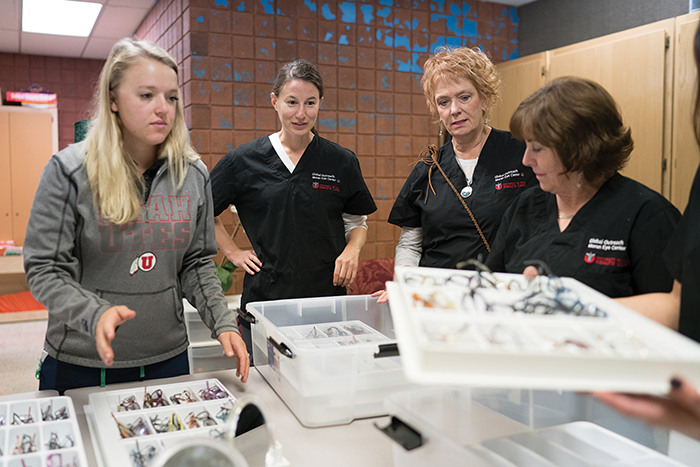
Figure 3 | In 2017, the Moran Eye Center dispensed 904 pairs of glasses among the members of Navajo Nation.
On one single day recently, our pediatric team examined an entire middle school in Blanding, Utah, and dispensed 51 pairs of glasses. We completed 10 cataract surgeries; preoperative visual acuity was worse than 20/60 in two patients and between 20/70 and counting fingers in most cases. One patient had hand motion vision and trachoma, with corneal neovascularization and a white cataract. All surgeries were successful, and the patients are seeing well postoperatively.
The following day, we examined 160 pediatric and adult patients. Another 128 pairs of glasses were dispensed, and we scheduled 11 patients for cataract surgery/IOL implantation and 15 for panretinal photocoagulation. Five new cases of glaucoma were diagnosed.
There is still much work to be done, but the first step is recognizing the disparaties and needs that exist among this population.
1. Navajo Nation Government. www.navajo-nsn.gov/history.htm. Accessed July 14, 2018.
2. Barclay E. Navajos fight their food desert with junk food and soda taxes. NPR. April 1, 2015. https://www.npr.org/sections/thesalt/2015/04/01/396607690/navajos-fight-their-food-desert-with-junk-food-and-soda-taxes. Accessed July 2, 2018.
3. Kunitz SJ. Ethics in public health research: changing patterns of mortality among American Indians. Am J Public Health. 2008;98(3):404-411.
4. Moore K. Statement of the friends of Indian Health to the subcommittee on Interior, Environment, and Related Agencies, Committee on Appropriations. March 19, 2013. https://docs.house.gov/meetings/AP/AP06/20130319/100485/HHRG-113-AP06-Wstate-MooreFAAPK-20130319.pdf. Accessed July 2, 2018.
5. Jones DS. The persistence of American Indian health disparities. Am J Public Health. 2006;96(12):2122-2134.
6. Shalala DE, Trujillo MH, Hartz GJ, Paisano EL. Trends in Indian health. 1999. www.ihs.gov/PublicInfo/Publications/trends98/front.pdf. Accessed July 2, 2018.
7. Roubideaux Y. Perspectives on American Indian health. Am J Public Health. 2002;92(9):1401-1403.
8. Espey DK, Jim MA, Cobb N, et al. Leading causes of death and all-cause mortality in American Indians and Alaska Natives. Am J Public Health. 2014;104(suppl 3):S303-S311.
9. Mansberger SL, Romero FC, Smith NH, et al. Causes of visual impairment and common eye problems in Northwest American Indians and Alaskan Natives. Am J Public Health. 2005;95(5):881-886.
10. Maples WC, Hermann M, Hughes J. Corneal astigmatism in preschool Native Americans. J Am Optom Assoc. 1997;68(2):87-94.
11. Dobson V, Miller JM, Sherrill DL, Harvey EM. Stability of astigmatism in Native American preschool children. Invest Ophthalmol Vis Sci. 2003;44(13):4773.
12. Harvey EM, Dobson V, Miller JM, et al. Prevalence of corneal astigmatism in Tohono O’odham Native American children aged 6 months to 8 years of age. Invest Ophthalmol Vis Sci. 2011;52(7):4350-4355.
13. Narayanasamy S, Vincent SJ, Sampson GP, Wood JM. Simulated astigmatism impairs academic-related performance in children. Ophthalmic Physiol Opt. 2015;35(1):8-18.
14. Berkow RL, Fleshman JK. Retinoblastoma in Navajo Indian children. Am J Dis Child. 1983;137(2):137-138.
15. Tamboli A, Podgor MJ, Horm JW. The incidence of retinoblastoma in the United States: 1974 through 1985. Arch Ophthalmol. 1990;108(1):128-132.
16. Peek ME, Cargill A, Huang ES. Diabetes health disparities: a systematic review of health care interventions. Med Care Res Rev. 2007;64(5 suppl):101S-56S.
17. Saydah SH, Imperatore G, Henkin L, et al. Trends and characteristics of self-reported case presentation of diabetes diagnosis among youth from 2002 to 2010: findings from the SEARCH for diabetes in youth study. Diabetes Care. 2015;38(6):e84-e85.

